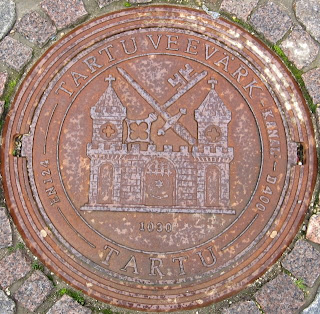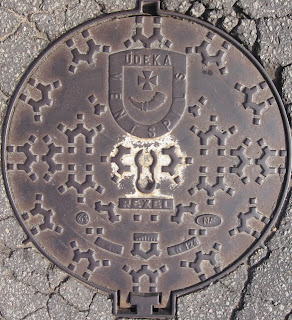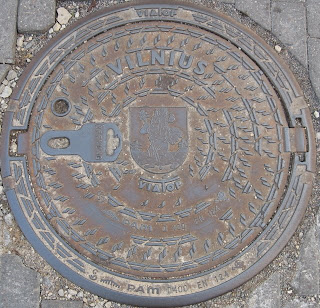It may seem thoughtless to lump the three Baltic states together with Russia, but the fact remains that the majority of the manhole covers on the streets of Estonia, Latvia and Lithuania date from the period of Soviet occupation. Gradually larger communities in all three countries are introducing their own pictorial designs, in many cases using the services of the French foundry at Pont-a-Mousson.
The Soviet manholes are listed under the places where they were seen. It would appear that the same covers were often supplied across the Soviet Union, although some specifically Latvian SSR ones were noted. I am greatly indebted to John Stephenson for the information on this page.
Abbreviations used on manhole covers
Note that some letters, eg K, can have more than one meaning.
| RU abbrev | EN abbrev | RU expansion | EN Transliteration | Translation |
| В | V | водопровод | vodoprovod | water supply |
| ВД | VD | водопровод | vodoprovod | water supply |
| Г | G | гидрант | gidrant | hydrant |
| ГВ | GV | городской водопровод | gorodskoj vodoprovod | municipal water supply |
| ГГ | GG | городской газопровод | gorodskoj gazoprovod | municipal gas main |
| ГК | GK | городская (бытовая и/или производственная) канализация | gorodskaya (bytovaya i/ili proizvodtsvennaya) kanalizatsiya | municipal (domestic and/or industrial) sewers |
| ГКС | GKS | городская кабельная сеть | gorodskaya kabel'naya set' | municipal cable network |
| ГС | GS | газовая сеть | gazovaya set' | gas network |
| ГТС | GTS | городская телефонная сеть | gorodskaya telefonnaya set' | municipal telephone network |
| Д | D | дренаж (ливневая канализация) | drenazh (livnevaya kanalizatsiya) | drainage (rainwater) |
| ДП | DP | дренажный приёмник | drenazhnyj priyomnik | drainage collector |
| К | K | (бытовая и/или производственная) канализация | (bytovaya i/ili proizvodtsvennaya) kanalizatsiya | (domestic and/or industrial) sewers |
| К | K | кабель | kabel' | cables |
| КК | KK | канализационный колодец | kanalizatsionnyj kolodets | sewer chamber |
| КУ | KU | коммутационный узел | kommutatsionnyj uzel | switching centre or point (prob. for switching current on/off) |
| ЛК | LK | ливневая канализация or колодец or коллектор | livnevaya kanalizatsiya or kollektor or kolodets | rainwater drainage or collector or chamber |
| МГ | MG | магистральный газопровод | magistral'nyj gazoprovod | main [ie, large] gas pipeline |
| МС | MS | Министерство Связи | Ministerstvo Svyazi | Ministry of Communications (Existed 1946-1991) |
| НКПиТ | NKPiT | Народный Комиссариат Почт и Телеграфов СССР | Narodnyj Komissariat Pocht i Telegrafov SSSR | People's Commissariat for Posts & Telegraphs (Existed from 1917-1932. In 1946 it was renamed the НКС (NKS) - qv) |
| НКПТ | NKPT | Народный Комиссариат Почт и Телеграфов СССР | Narodnyj Komissariat Svyazi SSSR | People's Commissariat for Posts & Telegraphs (Existed from 1917-1932. In 1946 it was renamed the НКС (NKS) - qv) |
| НКС | NKS | Народный Комиссариат Связи СССР | Narodnyj Komissariat Svyazi SSSR | People's Commissariat for Communications (Responsible for Posts & Telegraphs from 1932-1946. Before 1932 it was known as the НКПТ (NKPT) - qv) |
| МТ | MT | междугородная телефонная сеть | mezhdugorodnaya telefonnaya set' | inter-urban telephone network |
| ПГ | PG | пожарный гидрант | pozharnyj gidrant | fire hydrant |
| Р | R | ремонтная вставка | remontnaya vstavka | maintenance installation |
| Т | T | телефонная сеть | telefonnaya set' | telephone network |
| Т | T | теплосеть | teploset' | (central) heating network * |
| Теле-фон МС | Telefon MS | Телефон Министерства Связи | Telefon Ministerstva Svyazi | Ministry of Communications Telephones |
| ТМС | TMS | Телефон Министерства Связи | Telefon Ministerstva Svyazi | Ministry of Communications Telephones |
| ТС | TS | тепловая сеть | teplovaya set' | (central) heating network * |
| ТСОД | TSOD | техническая система обеспечения движения | tekhnicheskaya sistema obespecheniya dvizheniya | traffic control equipment |
| ЭЛЗ | EhLZ | электрозащита | ehlektrozashchita | electricity protector (found eg near electricity substations, they protect against lightning strikes etc) |
* Central heating in Russian blocks of flats is often provided by a single boiler serving all of the flats. In addition, during the Soviet era district boiler houses were built to supply heating to all of the flats, offices and factories in a district. Hence manhole covers for 'heating networks' are likely to appear on streets in the former Soviet Union.
Usage abbreviations
Some manhole covers also have one or two letters to indicate their load-bearing capacity and where they should be installed:
| RU abbrev | EN abbrev | RU expansion | EN Transliteration | Translation | Usage |
| Л | L | лёгкий люк | lyogkij lyuk | light manhole cover | green spaces and pedestrianised areas |
| С | S | средний люк | srednij lyuk | medium manhole cover | car parks and pavements |
| Т | T | тяжёлый люк | tyazhyolyj lyuk | heavy manhole cover | urban roads |
| ТМ | TM | тяжёлый магистральный люк | tyazhyolyj magistral'nyj lyuk | heavy trunk road manhole cover | trunk roads |
| СТ | CT | сверхтяжёлый люк | sverkhtyazhyolyj lyuk | super-heavy trunk road manhole cover | airfields and docks |
GOST numbers
ГОСТ = GOST = short for Gosudarstvennyj Standart = [USSR] State Standard.
In the USSR, GOST numbers served a similar purpose to our BS (British Standards) numbers, except that they were used much more widely. Because the quality of many Soviet goods was very poor, the Soviets brought in GOST numbers which, by the 1970s, covered just about every manufactured item imaginable, to ensure they met certain basic quality standards.
Each GOST number covers a specific, narrow category of product. In the official documentation each GOST number included a brief description explaining what sort of product(s) or service(s) it covered, eg, 'Vehicle oil sumps, aluminium, small.' GOST numbers were typically 4 digits long.
The hyphen plus two digits after the main number shows the year the standard was last updated/ revised prior to the product being made. So -68 means 'standard last updated 1968'. Each time a GOST was updated, Soviet manufacturers were expected to adopt the new standard and print/stamp it on their products.
The standard for cast-iron manhole covers will probably have specified what percentage of (say) iron, carbon, silicon etc must be used when making the covers, as well as specifying the load-bearing capacity of each of the classes (light, medium, heavy etc), and probably other details.
GOST 3634-61 covered 'Inspection chamber covers, cast-iron'. Eighteen years later in 1979 the specification was changed and the standard renumbered GOST 3634-79. Ten years after that the standard was re-specified again and replaced by GOST 3634 89. Ten years later still it was replaced by GOST 3634-99, when it was also re-titled 'Inspection chamber covers; rainwater gully covers; wastewater gully covers'. So in 1999 the 'cast-iron' specification was dropped, presumably because other materials had now become available with which to make manhole covers, and the range of items covered by the standard was widened.
GOST 3634-61 on a manhole cover indicates that it is made of cast iron and must have been made between 1961 and 1979 GOST 3634-79 on a manhole cover indicates that it is made of cast iron and must have been made between 1979 and 1989.
GOST 8591-57 covered 'Covers for cable inspection chambers and inspection boxes for urban telephone networks, lightweight'. It was replaced 19 years later by GOST 8591-76. This was replaced again 15 years later by GOST 8591-91.
GOST 8591-57 on a manhole cover indicates that it is for telephones and must have been made between 1957 and 1976.
Websites
A selection of many Russian websites showing pictures and descriptions of Russian/Soviet manhole covers and other street ironwork:
Riga area
Riga city centre
Yaroslavl' area
Estonian manhole covers
Hints for searching Russian websites for manhole cover pictures. On the Russian Google search page copy and paste the following into the search field:
"люк" manhole
"люки" manholes
"крышка люка" manhole cover
"крышки люков" manhole covers
Remember to include the quotation marks, at least to start off with, otherwise you may not get manhole-related sites.
Cesis
 Cesis Meistars L-600
Cesis Meistars L-600 Soviet period manhole cover manufactured 1898
Soviet period manhole cover manufactured 1898К = kanalizatsiya = sewers
ГОСТ 3634-79 – GOST (State Standard) No 3634, updated 1979
89 – year of manufacture
T – probably = tyazhyolyj lyuk = heavy usage
TM – perhaps: tyazholyj magistral'nyj = heavy-usage trunk road manhole cover - or more likely the manufacturer's/town's/water department's logo. It appears on several Russian websites as being a trade mark, but no further details are given.
 Palanga Parxess 700. Provided by Pont-a-Mousson
Palanga Parxess 700. Provided by Pont-a-Mousson Palanga Pamrex. Another Pont-a-Mousson manhole cover
Palanga Pamrex. Another Pont-a-Mousson manhole cover Riga 800
Riga 800 Rigas Pilsetas Ipasoms
Rigas Pilsetas Ipasoms Soviet period manhole cover dating from 1965
Soviet period manhole cover dating from 1965ГК – gorodskaya kanalizatsiya = municipal sewers
ГОСТ 3634-61 – State Standard No 3634, updated 1961
1965 – year of manufacture
Т – probably = tyazhyolyj lyuk = heavy usage
 ... ma Allmannas Telefon ... 1902. A rare example of an early telephone manhole cover.
... ma Allmannas Telefon ... 1902. A rare example of an early telephone manhole cover. Siauliai, Parexess 600. Provided by Pont-a-Mousson
Siauliai, Parexess 600. Provided by Pont-a-Mousson Soviet era manhole cover dating from 1974
Soviet era manhole cover dating from 1974ГОСТ 3634-61 – State Standard No 3634, updated 1961
1974 – year of manufacture
Л – probably = lyogkij lyuk = light usage
W symbol – must be a trade mark as this is not a Russian letter
 Lit. SSR. Soviet period manhole dating from 1987
Lit. SSR. Soviet period manhole dating from 1987ГК (upside down) – gorodskaya kanalizatsiya = municipal sewers
1987 – year of manufacture?
**-78 – unknown
ЛИТ. ССР – LIT. SSR = Lithuanian Soviet Socialist Republic
16-80 – unknown
P d – unknown. Presumably a trade mark as 'd' is not a Russian letter. An image in the Russian Wikipedia of a very similar manhole cover has a caption suggesting that 'P d' may indicate it was made in a Lithuanian corrective labour camp. The logo is shown in more detail on a Lithuanian Patent Office webpage.
 Soviet period manhole dating from 1987
Soviet period manhole dating from 1987К = kanalizatsiya = sewers
ГОСТ 3634-79 – GOST (State Standard) No 3634, updated 1979.
1987 – year of manufacture
Т – probably = tyazhyolyj lyuk = heavy usage
'Flame'-type logo – unknown
 Soviet period manhole dating from 1977
Soviet period manhole dating from 1977ГК – gorodskaya kanalizatsiya = municipal sewers
ГОСТ 3634-61 – State Standard No 3634, updated 1961
ЛСРЗ – LSRZ or LSR3 (the letter Z and number 3 are almost identical in Russian) – not found on web. Z at the end of Russian abbreviations often means zavod = plant (ie, factory)
1977 – year of manufacture
Л or V – If ?, possibly = lyogkij lyuk = light usage
If V, unknown as this is not a letter in Russian.
 Tallinna vesi anno 1997. Provided by Pont-a-Mousson
Tallinna vesi anno 1997. Provided by Pont-a-Mousson A.Tonnison & Ko, Tallinn. Probably from the period of independence, 1920s or 1930s
A.Tonnison & Ko, Tallinn. Probably from the period of independence, 1920s or 1930s Soviet period manhole dating from 1969
Soviet period manhole dating from 1969ГОСТ 3634-61 – State Standard No 3634, updated 1961
ПЯРНУСКИЙ ЗАВОД ПРОДМАШ – FOOD MACHINERY-BUILDING PLANT, PÄRNU. Pärnu is a town in SW Estonia. The Imperial Russian name for Pärnu was Pernov. This continued under Stalin. From the 1950s onwards, in order to appease nationalists in the Baltic states, the Russians in some cases began using local (Estonian, Lithuanian or Latvian) place-names and transliterated them into Russian, instead of using the traditional Russian names for them. Pyarnu is the Russian transliteration of the Estonian name Pärnu, so this is from the later Soviet period. A couple of Russian websites describe this plant as making equipment for the food industry "and other products." Not clear why this manhole cover should have this plant's name on it.
1969 – year of manufacture
T – probably = tyazhyolyj lyuk = heavy usage
 Tallinna vesi, annno 1997
Tallinna vesi, annno 1997 Soviet period manhole dating from 1979
Soviet period manhole dating from 1979Logo in centre – Unknown
ГОСТ 3634-61 – State Standard No 3634, updated 1961
1979 – year of manufacture
T – probably = tyazhyolyj lyuk = heavy usage
 Soviet period manhole dating from 1976
Soviet period manhole dating from 1976ГК – gorodskaya kanalizatsiya = municipal sewers
ГОСТ 3634-61 – State Standard No 3634, updated 1961
1976 – year of manufacture
Т – probably = tyazhyolyj lyuk = heavy usage
 Undated Soviet era manhole cover manufactured between 1957 and 1976
Undated Soviet era manhole cover manufactured between 1957 and 1976ГОСТ 8591 57 – State Standard No 8591, updated 1957
С – unknown
5 (upside down) – unknown. This must be a '5', as there is no letter S in Russian.
Л – probably = lyogkij lyuk = light usage
Г – unknown. Probably not gidrant = hydrant, as this doesn't tie in with the GOST no specification that this is for telephones
Т – probably = tyazhyolyj lyuk = heavy usage
 Soviet era manhole covers dating from 1975
Soviet era manhole covers dating from 1975ГОСТ 3634-61 – State Standard No 3634, updated 1961
ПЯРНУСКИЙ ЗАВОД ПРОДМАШ – FOOD MACHINERY-BUILDING PLANT, PÄRNU (See notes above)
1975 – year of manufacture
T – probably = tyazhyolyj lyuk = heavy usage
 Soviet period manhole dating from 1969
Soviet period manhole dating from 1969Identical marking to TALLIN-05
 Undated Soviet period manhole cover
Undated Soviet period manhole coverРМЗ = RMZ – Unclear, presumably this the manufacturer's initials. A couple of Russian manhole cover websites show covers similar to this and refer to RMZ as the manufacturer, but don't expand it. The Z at the end is probably short for zavod = plant (ie, factory).
ТАЛЛИН – TALLIN
 Tartu Veevark
Tartu Veevark Udeka Ventspils. Provided by Pont-a-Mousson
Udeka Ventspils. Provided by Pont-a-Mousson Magistrat m. Wilna
Magistrat m. Wilna Vilnus rysiai. A Pont-a-Mousson manhole
Vilnus rysiai. A Pont-a-Mousson manhole Vilnius Viatop. Another Pont-a-Mousson manhole
Vilnius Viatop. Another Pont-a-Mousson manhole Vilnius Nuotekos
Vilnius Nuotekos A tsarist period manhole seen in front of the Russian Orthodox Cathedral in Liepaja
A tsarist period manhole seen in front of the Russian Orthodox Cathedral in LiepajaОБЩЕСТВО / ЦЕМЕНТО БЕТОННАГО / ПРОИЗВОДСТВА / С. ПЕТЕРБУРГЪ = OBShchESTVO / TsEMENTO BETONNAGO / PROIZVODSTVA / S. PETERBURG = CEMENT & CONCRETE PRODUCTS COMPANY St PETERSBURG
This is written in pre-1917 Russian. It is also probably pre-1914, as St Petersburg was renamed Petrograd in 1914. This doesn't explain why a 'Cement & Concrete Products Company' would produce something apparently made of iron – but that's what it says. Perhaps they built the whole manhole and supplied their own cover?
 Windschild & Langelott AG, Koenigsberg. Dating from when Kaliningrad was part of Germany, this manhole was seen in Frombork, Poland
Windschild & Langelott AG, Koenigsberg. Dating from when Kaliningrad was part of Germany, this manhole was seen in Frombork, PolandThis page last updated 1 August 2012